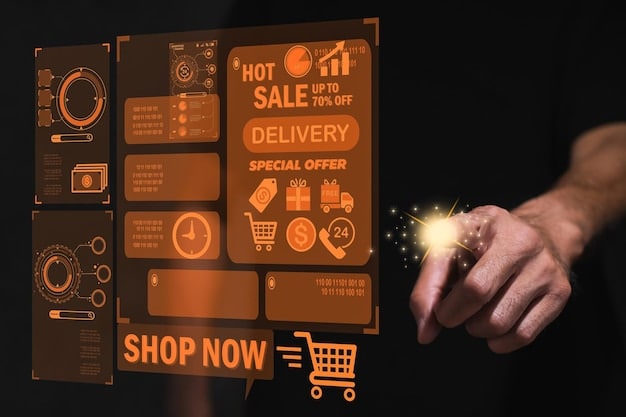E-commerce Automation: Maximize Digital Marketing Efficiency

E-commerce automation streamlines digital marketing by automating repetitive tasks, personalizing customer experiences, and optimizing marketing campaigns, leading to improved efficiency and increased sales.
Ready to unlock the full potential of your e-commerce business? E-commerce automation: Streamlining your digital marketing for maximum efficiency is the key. Let’s explore how automation can transform your online store, saving you time and boosting your bottom line.
Understanding the Basics of E-commerce Automation
E-commerce automation is more than just a buzzword; it’s a necessity in today’s competitive landscape. It’s about leveraging technology to automate tasks that would otherwise consume valuable time and resources. By automating these processes, you can focus on strategic initiatives that drive growth.
This involves using software and tools to manage various aspects of your online business, from order fulfillment to customer communication and marketing. The goal is to create a seamless, efficient operation that maximizes productivity and profitability.
What Can E-commerce Automation Do?
E-commerce automation offers a wide range of capabilities, allowing you to handle different facets of your business with ease. From streamlining customer service to optimizing your marketing efforts, its potential is vast.
- Automated Email Marketing: Send personalized emails based on customer behavior, such as abandoned carts or recent purchases.
- Inventory Management: Automatically update inventory levels to prevent overselling and stockouts.
- Order Fulfillment: Streamline the shipping process, from order confirmation to tracking updates.
- Customer Service: Use chatbots to answer common questions and provide instant support.
In essence, e-commerce automation helps you create a more efficient and customer-centric online store, leading to increased sales and customer satisfaction.
Benefits of Streamlining Digital Marketing with Automation
The advantages of integrating automation into your digital marketing efforts are numerous. It’s not just about saving time; it’s about creating more effective and targeted campaigns that resonate with your audience.
By automating key processes, you can ensure that your marketing efforts are consistent, personalized, and optimized for maximum impact. This can lead to increased engagement, higher conversion rates, and improved customer loyalty.

Enhanced Efficiency and Productivity
One of the primary benefits of e-commerce automation is the significant boost in efficiency and productivity. By automating repetitive tasks, you free up your team to focus on more strategic initiatives.
- Reduced Manual Work: Automation eliminates the need for manual data entry and repetitive tasks, reducing errors and saving time.
- Improved Resource Allocation: Staff can focus on higher-value activities such as product development and customer relationship building.
- Faster Turnaround Times: Automated processes speed up order fulfillment and customer service, leading to happier customers.
For example, automated email campaigns can be set up to send personalized messages to customers based on their browsing behavior. This level of personalization would be impossible to achieve manually.
Key Areas for E-commerce Automation in Marketing
Identifying the right areas for automation is crucial to maximizing its impact. Several key areas within e-commerce marketing are ripe for automation, offering significant potential for improvement.
These areas include email marketing, social media management, customer relationship management (CRM), and advertising. By automating these processes, you can create a more cohesive and effective marketing strategy.
Email Marketing Automation
Email marketing remains one of the most effective channels for reaching customers, and automation can take it to the next level. From welcome emails to personalized product recommendations, the possibilities are endless.
- Welcome Emails: Automatically send a welcome email to new subscribers, introducing your brand and offering exclusive deals.
- Abandoned Cart Reminders: Remind customers about items left in their cart, encouraging them to complete their purchase.
- Personalized Recommendations: Suggest products based on past purchases or browsing history.
- Promotional Campaigns: Automate the delivery of promotional emails based on specific triggers or customer segments.
By automating these email marketing efforts, you can ensure that your customers receive timely and relevant messages, leading to increased engagement and sales.
Choosing the Right Automation Tools
Selecting the right automation tools is essential for successful implementation. With so many options available, it’s important to choose tools that align with your specific needs and goals.
Consider factors such as integration capabilities, ease of use, scalability, and cost. You want tools that seamlessly integrate with your existing e-commerce platform and other marketing systems.

Popular E-commerce Automation Platforms
Several platforms stand out as top choices for e-commerce automation. These tools offer a wide range of features and capabilities to streamline your marketing efforts.
- Klaviyo: Specializes in email marketing automation and offers advanced segmentation and personalization features.
- Omnisend: An all-in-one marketing automation platform designed for e-commerce businesses.
- HubSpot: A comprehensive marketing automation platform that includes email, social media, and CRM features.
- ActiveCampaign: Known for its powerful automation capabilities and advanced customer segmentation.
Each of these platforms offers unique advantages, so it’s important to evaluate your specific needs and choose the one that best fits your business.
Implementing E-commerce Automation: A Step-by-Step Guide
Implementing e-commerce automation doesn’t have to be daunting. By following a step-by-step guide, you can ensure a smooth and successful rollout.
Start by identifying your goals and objectives, then select the right tools and create a detailed implementation plan. Test and optimize your automated processes to ensure they are delivering the desired results.
Step 1: Define Your Goals
Before you start automating, it’s crucial to define your goals. What do you want to achieve with e-commerce automation? Are you looking to increase sales, improve customer service, or streamline operations?
Setting clear goals will help you prioritize your efforts and measure your success. Some common goals include:
- Increase conversion rates
- Improve customer retention
- Reduce operational costs
- Enhance customer satisfaction
Once you have defined your goals, you can begin to develop a strategy for achieving them through automation.
Measuring the Success of Your Automation Efforts
Measuring the success of your automation efforts is crucial for ongoing improvement. By tracking key metrics, you can identify what’s working and what needs to be adjusted.
Monitor metrics such as conversion rates, customer engagement, and operational efficiency to gain insights into the effectiveness of your automation strategies. Use data to make informed decisions and optimize your processes for maximum impact.
Key Performance Indicators (KPIs) to Track
Several KPIs can help you gauge the success of your e-commerce automation efforts. These metrics provide valuable insights into different aspects of your business.
- Conversion Rate: The percentage of visitors who make a purchase.
- Customer Retention Rate: The percentage of customers who return to make additional purchases.
- Email Open Rate: The percentage of recipients who open your emails.
- Click-Through Rate: The percentage of recipients who click on links in your emails.
By monitoring these KPIs, you can gain a comprehensive understanding of how your automation strategies are performing and make adjustments as needed.
| Key Aspect | Brief Description |
|---|---|
| 🚀 Automation Basics | Streamlines e-commerce operations, saving time and resources. |
| 🎯 Key Automation Areas | Includes email marketing, social media, and customer relationship management. |
| 🛠️ Choosing Tools | Select tools that align with your needs for seamless integration. |
| 📈 Measuring Success | Track KPIs like conversion rate and customer retention. |
Frequently Asked Questions (FAQs)
▼
E-commerce automation involves using software and tools to automate repetitive tasks in your online store. This includes processes like inventory management, order fulfillment, and customer communication.
▼
Many marketing tasks can be automated, including email marketing, social media posting, and customer segmentation. Automated campaigns can be triggered by specific customer actions or events.
▼
Automation can improve customer satisfaction by providing faster responses, personalized experiences, and efficient order processing. Chatbots and automated emails can address customer inquiries promptly.
▼
Automated email marketing allows you to send targeted messages to customers based on their behavior, preferences, and purchase history. This can increase engagement, drive sales, and improve customer retention.
▼
Consider factors such as your budget, business needs, technical expertise, and integration capabilities when choosing automation tools. Start with a free trial to test the tool and ensure it fits your requirements.
Conclusion
E-commerce automation: Streamlining your digital marketing for maximum efficiency is not just a trend; it’s a strategic imperative for businesses looking to thrive in the digital age. By embracing automation, you can unlock new levels of efficiency, personalization, and profitability, ultimately leading to a more successful and sustainable e-commerce business.





